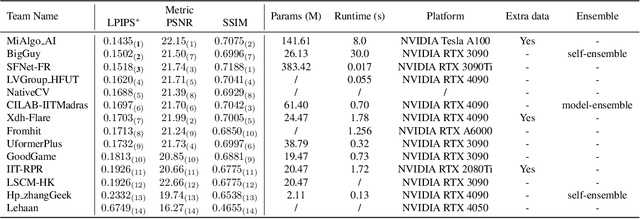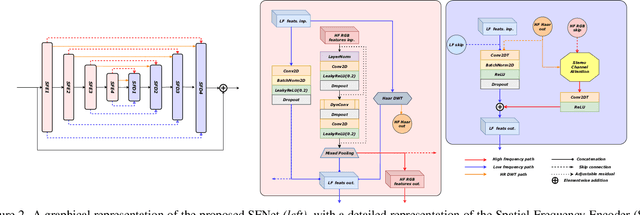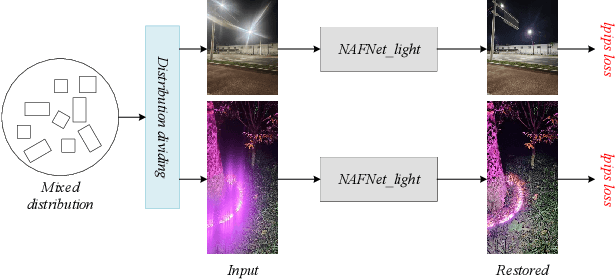Qihua Cheng
DSDNet: Raw Domain Demoiréing via Dual Color-Space Synergy
Apr 22, 2025Abstract:With the rapid advancement of mobile imaging, capturing screens using smartphones has become a prevalent practice in distance learning and conference recording. However, moir\'e artifacts, caused by frequency aliasing between display screens and camera sensors, are further amplified by the image signal processing pipeline, leading to severe visual degradation. Existing sRGB domain demoir\'eing methods struggle with irreversible information loss, while recent two-stage raw domain approaches suffer from information bottlenecks and inference inefficiency. To address these limitations, we propose a single-stage raw domain demoir\'eing framework, Dual-Stream Demoir\'eing Network (DSDNet), which leverages the synergy of raw and YCbCr images to remove moir\'e while preserving luminance and color fidelity. Specifically, to guide luminance correction and moir\'e removal, we design a raw-to-YCbCr mapping pipeline and introduce the Synergic Attention with Dynamic Modulation (SADM) module. This module enriches the raw-to-sRGB conversion with cross-domain contextual features. Furthermore, to better guide color fidelity, we develop a Luminance-Chrominance Adaptive Transformer (LCAT), which decouples luminance and chrominance representations. Extensive experiments demonstrate that DSDNet outperforms state-of-the-art methods in both visual quality and quantitative evaluation, and achieves an inference speed $\mathrm{\textbf{2.4x}}$ faster than the second-best method, highlighting its practical advantages. We provide an anonymous online demo at https://xxxxxxxxdsdnet.github.io/DSDNet/.
Learning Differential Pyramid Representation for Tone Mapping
Dec 02, 2024



Abstract:Previous tone mapping methods mainly focus on how to enhance tones in low-resolution images and recover details using the high-frequent components extracted from the input image. These methods typically rely on traditional feature pyramids to artificially extract high-frequency components, such as Laplacian and Gaussian pyramids with handcrafted kernels. However, traditional handcrafted features struggle to effectively capture the high-frequency components in HDR images, resulting in excessive smoothing and loss of detail in the output image. To mitigate the above issue, we introduce a learnable Differential Pyramid Representation Network (DPRNet). Based on the learnable differential pyramid, our DPRNet can capture detailed textures and structures, which is crucial for high-quality tone mapping recovery. In addition, to achieve global consistency and local contrast harmonization, we design a global tone perception module and a local tone tuning module that ensure the consistency of global tuning and the accuracy of local tuning, respectively. Extensive experiments demonstrate that our method significantly outperforms state-of-the-art methods, improving PSNR by 2.58 dB in the HDR+ dataset and 3.31 dB in the HDRI Haven dataset respectively compared with the second-best method. Notably, our method exhibits the best generalization ability in the non-homologous image and video tone mapping operation. We provide an anonymous online demo at https://xxxxxx2024.github.io/DPRNet/.
NTIRE 2024 Challenge on Night Photography Rendering
Jun 18, 2024



Abstract:This paper presents a review of the NTIRE 2024 challenge on night photography rendering. The goal of the challenge was to find solutions that process raw camera images taken in nighttime conditions, and thereby produce a photo-quality output images in the standard RGB (sRGB) space. Unlike the previous year's competition, the challenge images were collected with a mobile phone and the speed of algorithms was also measured alongside the quality of their output. To evaluate the results, a sufficient number of viewers were asked to assess the visual quality of the proposed solutions, considering the subjective nature of the task. There were 2 nominations: quality and efficiency. Top 5 solutions in terms of output quality were sorted by evaluation time (see Fig. 1). The top ranking participants' solutions effectively represent the state-of-the-art in nighttime photography rendering. More results can be found at https://nightimaging.org.
MIPI 2024 Challenge on Nighttime Flare Removal: Methods and Results
Apr 30, 2024



Abstract:The increasing demand for computational photography and imaging on mobile platforms has led to the widespread development and integration of advanced image sensors with novel algorithms in camera systems. However, the scarcity of high-quality data for research and the rare opportunity for in-depth exchange of views from industry and academia constrain the development of mobile intelligent photography and imaging (MIPI). Building on the achievements of the previous MIPI Workshops held at ECCV 2022 and CVPR 2023, we introduce our third MIPI challenge including three tracks focusing on novel image sensors and imaging algorithms. In this paper, we summarize and review the Nighttime Flare Removal track on MIPI 2024. In total, 170 participants were successfully registered, and 14 teams submitted results in the final testing phase. The developed solutions in this challenge achieved state-of-the-art performance on Nighttime Flare Removal. More details of this challenge and the link to the dataset can be found at https://mipi-challenge.org/MIPI2024/.
Learning to See Low-Light Images via Feature Domain Adaptation
Dec 20, 2023Abstract:Raw low light image enhancement (LLIE) has achieved much better performance than the sRGB domain enhancement methods due to the merits of raw data. However, the ambiguity between noisy to clean and raw to sRGB mappings may mislead the single-stage enhancement networks. The two-stage networks avoid ambiguity by decoupling the two mappings but usually have large computing complexity. To solve this problem, we propose a single-stage network empowered by Feature Domain Adaptation (FDA) to decouple the denoising and color mapping tasks in raw LLIE. The denoising encoder is supervised by the clean raw image, and then the denoised features are adapted for the color mapping task by an FDA module. We propose a Lineformer to serve as the FDA, which can well explore the global and local correlations with fewer line buffers (friendly to the line-based imaging process). During inference, the raw supervision branch is removed. In this way, our network combines the advantage of a two-stage enhancement process with the efficiency of single-stage inference. Experiments on four benchmark datasets demonstrate that our method achieves state-of-the-art performance with fewer computing costs (60% FLOPs of the two-stage method DNF). Our codes will be released after the acceptance of this work.
 Add to Chrome
Add to Chrome Add to Firefox
Add to Firefox Add to Edge
Add to Edge